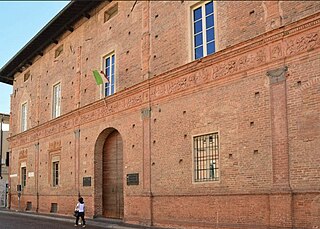Related Research Articles

Piacenza is a city and comune (municipality) in the Emilia-Romagna region of Northern Italy, and the capital of the eponymous province. As of 2022, Piacenza is the ninth largest city in the region by population, with more than 102,000 inhabitants.

Pietro da Cortona was an Italian Baroque painter and architect. Along with his contemporaries and rivals Gian Lorenzo Bernini and Francesco Borromini, he was one of the key figures in the emergence of Roman Baroque architecture. He was also an important designer of interior decorations.

Giovanni Lanfranco was an Italian painter of the Baroque period.

Sant'Agnese in Agone is a 17th-century Baroque church in Rome, Italy. It faces onto the Piazza Navona, one of the main urban spaces in the historic centre of the city and the site where the Early Christian Saint Agnes was martyred in the ancient Stadium of Domitian. Construction began in 1652 under the architects Girolamo Rainaldi and his son Carlo Rainaldi. After numerous quarrels, the other main architect involved was Francesco Borromini.

Castell'Arquato is an Italian town located on the first hills of Val D’Arda in the province of Piacenza, in Emilia-Romagna, approximately 30 kilometres (19 mi) from Piacenza and 35 kilometres (22 mi) from Parma. Places nearby include Bacedasco, Vigolo Marchese, Fiorenzuola d'Arda, Lugagnano Val d'Arda, and Vernasca. It is one of I Borghi più belli d'Italia.
Giovanni Evangelista Draghi (1654–1712) was an Italian painter of the late-Baroque or Rococo period. Luigi Lanzi erroneously refers to him as Giovanni Battista Draghi, who should not be confused with the composer of the same name.

San Giovanni in Canale is a Gothic-style Roman Catholic church located on Via Croce #26 in central Piacenza, formerly associated with a Dominican monastery.

The Palazzo Pepoli Campogrande, also known as Palazzo Pepoli Nuovo, is a Baroque style palace on Via Castiglione 7 in central Bologna, region of Emilia-Romagna, Italy. In 2015, it served as a public art gallery for late-Baroque art. Across the Via, rises the medieval Palazzo Pepoli Vecchio, also once pertaining to the same family, which now serves as a museum of the history of Bologna.

San Francesco is a Roman Catholic church, located on Piazza Cavalli #68 in Piacenza, Italy. It was built in a style described as Lombard Gothic and is centrally located facing towards the Piazza del Cavalli, which is surrounded by the Palazzo Gotico and the Palazzo del Governatore.
The Palazzo Costa is a Baroque style palace located on Via Roma #80 in Piacenza, Region of Emilia Romagna, Italy. The Museo Ambientale displaying period art and artifacts is now hosted by part of the palace.

The Palazzo Bichi Ruspoli, or previously Palazzo or Castellare dei Rossi, is an urban palace, located on Via Banchi di Sopra in the present contrada of Civetta, Terzo di Camollia of the city of Siena, region of Tuscany, Italy.
The Palazzo Capponi is a Baroque palace located on Via Gino Capponi #26 in Florence, region of Tuscany, Italy. There are apparently three other palaces once associated with the Capponi family:

The Palazzo Moroni is a palace located on Via Porta #12 in the historic center of the upper town of Bergamo, Italy. The palace is a civic art museum, as well as used for cultural functions. The building, noted for its Baroque interior decorations, is presently managed by the Fondazione di Palazzo Moroni in conjunction with the city after a donation by Count Antonio Moroni.

San Leone, once called the oratory or church of Santo Spirito, is a small Baroque-style Roman Catholic church located adjacent to the Vivarelli Colonna in Pistoia, region of Tuscany, Italy. In 2017, restoration of the Baroque era frescoes in the apse and ceilings were completed.

San Nicolò is a Romanesque and Gothic-style, Roman Catholic church in Padua, region of Veneto, Italy. It stands in front of a homonymous piazza, and is adjacent to the Palazzo Meschini and Palazzo Brunelli-Bonetti.

Palace Carminali Bottigella is a noble palace built by the ancient Beccaria family from Pavia. The original structure from the Sforza era was built between 1490 and 1499. The façade, which retains the original terracotta decorations, is one of the major examples of Renaissance civil building in Pavia.
San Vincenzo is a Baroque style, Roman Catholic church, now deconsecrated, located at Via Scalabrini #6 in the South-East quadrant of Piacenza, Region of Emilia Romagna, Italy. The church was restored starting in 2009 for use as an auditorium and to host concerts.
The Teatro Municipale or Municipal Theater of Piacenza is the main Neoclassical-style opera house in the city, located on Via Verdi #41, facing Piazza Sant'Antonino and flanking the Palazzo Anguissola di Cimafava Rocca in Piacenza, Italy.
The Palazzo Anguissola di Cimafava Rocca, also called Palazzo Anguissola Rocca is an 18th-century aristocratic palace located on Via Pietro Giordano #2, west and across the street from the Teatro Municipale in Piacenza, Region of Emilia Romagna, Italy.
The Palazzo Ferrari Sacchini is a Baroque architecture-style aristocratic palace located at Via Giosuè Carducci #11 in central Piacenza, region of Emilia-Romagna in Italy. The palace also is referred to as the Palazzo Ferrari-Sacchini-Calciati-Costa referring to subsequent owners. The palace is now home to the local ministry of the treasury.
References
- ↑ Prefettura of Piacenza, official site.